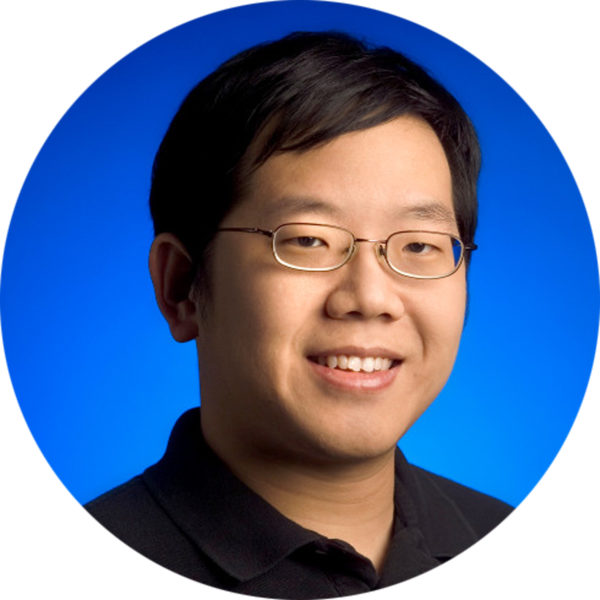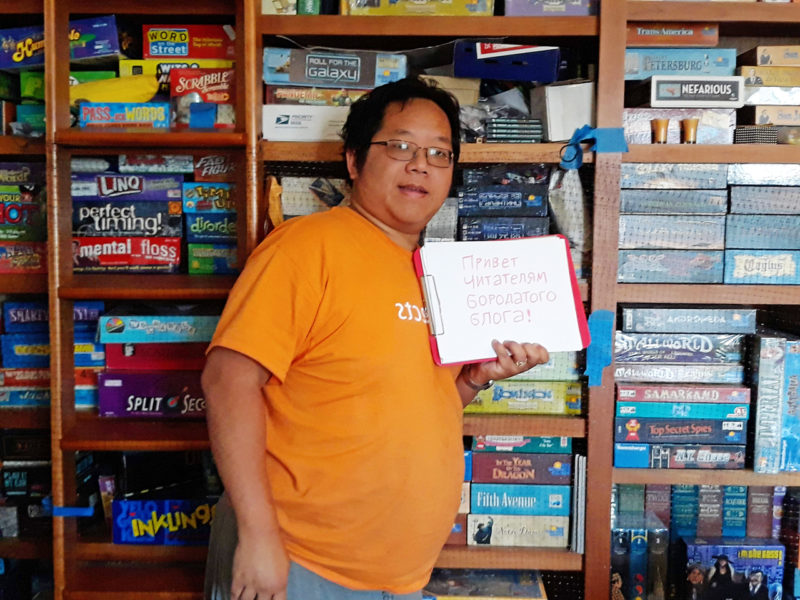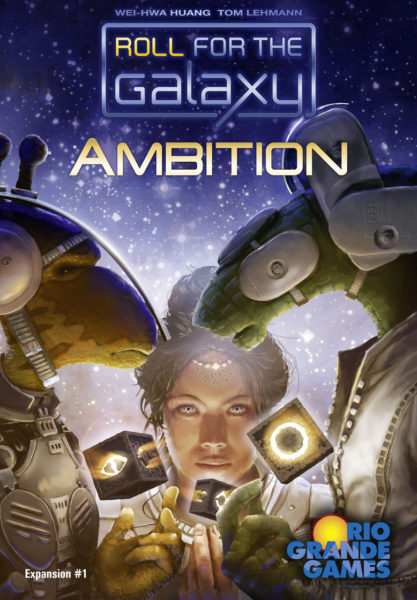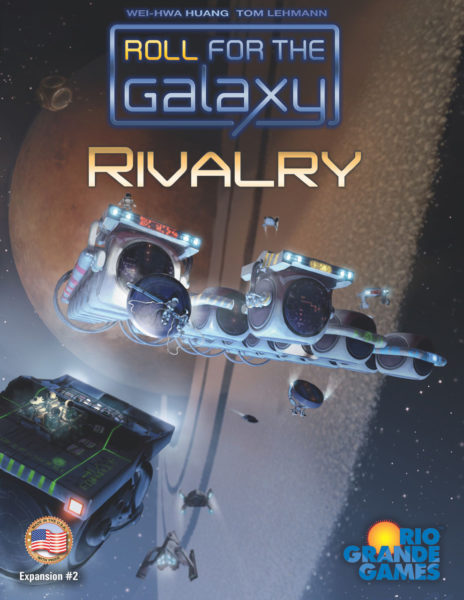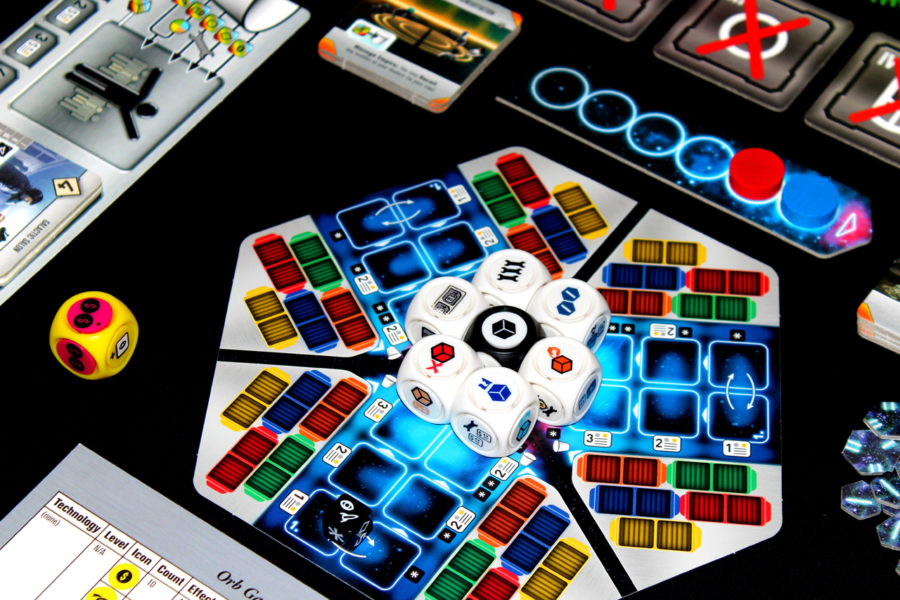I assume that if you ask a board game enthusiast who Tom Lehmann is, there will be no confusion. On the contrary, most likely such titles as «Race for the Galaxy» (and its distant relatives «Roll for the Galaxy» and «New Frontiers») and fresh «Res Arcana» may come up. One more experienced would be even able to name his other designs. So, it is a well-known author.
But if an attentive person takes a look at the «Roll for the Galaxy» box, another name would be noticed. And it is the one that goes first. Wei-Hwa Huang? Who is he and what does he have to do with Tom Lehmann and «Roll for the Galaxy»? Well, it seems a lot. But I think it would be better if Wei tells us about it, so the floor is his.
Hello Mr. Huang. Thank you for agreeing to do this interview. I suggest we start with a question that I think may be of interest to many: tell us about yourself and what you do when you’re not designing board games.
I was born and raised in the United States (with an exception of 5 years in elementary and junior high school, when I lived in Taiwan). When growing up all my teachers thought I’d probably grow up to be a great mathematician, because of my skills in class and competition. That hasn’t happened.
About 10 years ago I left my job as a software engineer, partly because of burnout and partly because I had enough money to live off of for a while. I thought I would take it easy for a few years, do the occasional board game or puzzle design project, and eventually go back to a regular job. That hasn’t happened either. Instead, my current full-time job is being a stay-at-home father for a pair of 2-year-old twins (although my wife has much longer hours at that job than I do). I sometimes take a few hours off here and there to continue game and puzzle design, or fun side activities like playing pinball or escape rooms.
On your Wikipedia page it is stated you are a “puzzler”. Could you explain the term and what it means? Is it somehow related to jigsaw puzzles or is it a broader term?
Somewhat broader. The types of puzzles that the general public knows are jigsaw puzzles, crossword puzzles, mechanical puzzles like the Rubik’s Cube, and (more recently) Sudoku. I am experienced in all of these, to the extent of even being professionally paid for them. My most recent large project as a puzzle designer was as the main puzzle consultant for the Red Bull Escape Room World Championships.
You were on the US team and competed many times in the World Puzzle Championship as its member. What is the World Puzzle Championship and how long has it been around? How successful were the efforts of your team? Are you still a member?
The World Puzzle Championship is a yearly competition run by the World Puzzle Federation. It is held in a different country each year and each country can send a team of up to 4 players to compete. The competition is mostly paper-and-pencil puzzles that require quick thinking and logic — no tools are allowed.
The first WPC was in 1992. I competed in the US Team Qualifying test to represent USA in 1993, and I have managed to attend every year since then (although in some recent years, I have only competed unofficially as there were four other Americans who scored better than me on the qualifying test.)
In 2018 in Prague, I was part of the USA team again, and we got second place behind Germany. The US team has taken first place 14 times and I was on the team for 11 of those times. I’ve also won individual first place four times, although those were in the early years before competition got really fierce.
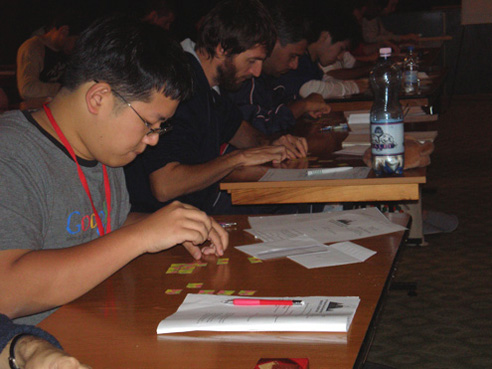
Out of a national interest, so to say: have you competed against a Russian team (if such exists) during the championship?
Russia sends a team to the WPC every year. The Russian team is currently being organized by Planet of Puzzles. In 2018 they were 15th.
What do you think about board games? If you play them, do you use the games for training or can you afford to enjoy games for your own pleasure?
Before I had children, I played board games every week and sometimes more, often with my wife. But for the past two years we’ve had to cut down our board game playing quite significantly, although my collection of almost a thousand board games keeps on taunting me.
Despite my other hobbies, I actually do not play board games for serious competition or training — it is almost always for fun. A few years back I entered a «Dominion» tournament and won a small prize, which was to have my likeness depicted on a card.
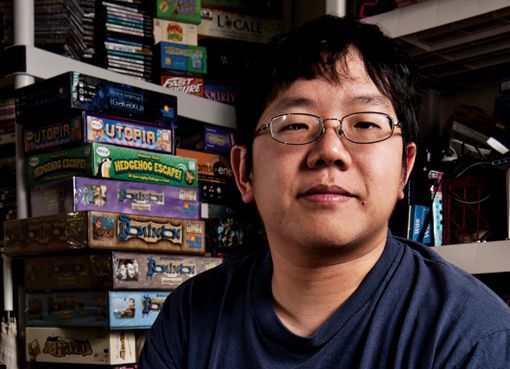
Currently your designer resume includes only one title – «Roll for the Galaxy», but it is a game that is highly regarded and is in BoardGameGeek Top 100. What I’m really impressed with is how controlled the randomness provided by dice is in your game. Even though we use a large number of dice the way everything is designed allows you to actually plan your actions. The game has its share of fans in Russia, and their numbers increased following release of the official Russian edition couple of years ago. Have you anticipated this kind of success?
I was hoping the game would be a huge success, but I certainly did not expect the game to be successful, if that makes sense to you.
In your opinion, what is the cause of such popularity?
I think that the way in which the game uses dice is very original (no other game uses dice in the same way) and is just barely easy enough to understand after you have played a few turns. As you alluded to, the randomness feels more controllable, which helps players feel that their strategic and tactical decisions matter. When combined with an engine-building structure, a science-fiction theme, and some beautiful art, there’s a lot of different things that players can enjoy about the game.
How did the idea of collaboration with Tom Lehmann originate? How much Mr. Lehmann contributed to the designing process? Was the game planned as dice version of «Race for the Galaxy» from the get-go or was there a mechanic first that the «RftG» setting was pulled on later?
Tom and I have known worked together seriously for 15 years now, ever since I created a new graphic design for «Race for the Galaxy» when it was still in prototype form and he felt that there was potential to develop that design further before submitting the game to a publisher. But our relationship on «Race for the Galaxy» was very much he was the game designer, while I worked with him on the visual design and led several playtesting groups.
After «Race» was published and successful with several expansions, we were approached by an aspiring designer who had designed a Race for the Galaxy dice game and asked us to evaluate it. We did, and Tom and I agree that while the game had potential, it didn’t feel like it quite belonged as a successor to «Race». So, we recommended to the publisher that they rejected it, and they did so.
But the whole process was a clear indication to us that clearly our publisher, Rio Grande Games, was interested in seeing a dice game in the «Race for the Galaxy» universe, and so both of us started thinking about the potential. Six months later, we both had ideas for how a «RftG» dice game might work. But Tom was busy with other projects and didn’t develop his dice game idea further, whereas I was able to get my game to a playable prototype. That playable prototype had most of the core mechanic you see in the published game — everybody owns their own dice, rolls them simultaneously, and the dice faces that are rolled are used for certain phases. The biggest thing that the prototype didn’t have was the concept of money («Galactic Credits», as the published game calls them). Instead, actions such as selling would result in you immediately putting dice into your cup. Despite that and many other omissions (for example, developments didn’t have powers!), the publisher liked it enough to approve further development.
At that point, Tom and I had a serious discussion. There were two options that seemed viable. We could try to «swap roles» compared to «Race», where I would take sole designer credit, and Tom would give design advice and help with playtesting; or we could be co-designers, in which case Tom would take a much more active role in thinking about how to make the game design better. I decided that the game would be much more successful if Tom was a co-designer, and not just because of name recognition. I’ve never regretted that decision. Tom contributed some subtle but important changes to the game; I’d say that the two most important ones were (1) realizing that the expensive planets needed to give some «money back» to justify their investment and (2) changing the distribution of the faces on the dice to be more extreme so that the different colored dice really felt different from each other.
Is there something that you would have changed, removed or added to the base «Roll for the Galaxy» now, looking at it through the prism of the time passed?
An emergent strategy that we knew about but didn’t investigate too strongly during game development is the deep fishing strategy, where you spend early turns heavily churning through tiles until you find a strong development combo. It definitely feels strong, although I disagree with the adherents who believe that it is a dominant strategy. But what it does do is that it slows down the game while also channeling groupthink. If I had to go through it again, I’d want to study that strategy more and see if there’s a way to not have it affect game speed so much.
The first expansion, «Ambition», was released a year later after the base game. It was warmly received by those who appreciated the dice Galaxy. However, the next expansion titled «Rivalry» was announced only in 2018 and released (at least in the US) in 2019. Why was there such a long pause between the two expansions?
The publishing time hides how long games are actually under development. That first prototype of «Roll» I mention above was done in summer of 2010. The design was finalized and sent to the publisher in summer of 2013, three years later, and the game was published in late 2014. At the time, we had no idea whether the game was going to be popular enough to warrant an expansion or not. It wasn’t until after the game had been out for a few months that we felt confident enough with sales figures that it made sense to develop the first expansion — and we knew we needed to get it out quickly.
«Ambition» started development in March 2015 and was submitted to the publisher four months later. It was a very grueling four months where Tom and I basically put all other projects aside and did a lot of rapid prototyping and pushed our playtesters repeatedly. The result was fine, but one big reason was that we had actually designed an expansion with more content and decided that because of timing it was better to throw away what wasn’t working than to try to fix it. A lot of the discarded Ambition ideas ended up showing up in «Rivalry». After «Ambition», we both suffered from creative burnout, and we were also rather tense with each other as we had to work through some of our social incompatibilities that surfaced during the session; we basically spent a year not working on «Roll» after that.
One result of this is that the second expansion we tried not to pressure ourselves as much with. The first prototype of «Rivalry» was done in August 2016, and we turned our final design into the publisher in April 2017. So, it was really only 8 months of development as opposed to «Ambition»’s 4-month development, but it felt a lot more comfortable. This time around, though, because of the sheer amount of material and new art in «Rivalry» (not to mention other projects in the pipeline, such as Tom’s «New Frontiers» game), it took the publisher a lot more time to get it from design to actual publication date.
As far as I understand, «Rivalry» includes three expansions released in one box. Can you tell us in brief what exactly they bring to the game?
The first expansion, which gets overshadowed in reviews, is the «more of the same» expansion that many fans ask for. New starting factions, new tiles to throw into the bag, and a new blue die. There are some interesting changes in these tiles — the new factions encourage certain color combos, the new tiles give interesting benefits but require you to sacrifice something — but for the most part, any player who is experienced with base «Roll for the Galaxy» and throw the new tiles in and start play.
The second expansion is the Deal expansion, which allows players to trade various assets of their empire for other assets. The variety of things you can Deal in the expansion really opens up the amount of strategic and tactical possibilities.
The third expansion is the Orb expansion, which gives each player a special Alien Orb die that they roll every turn for large benefits (much better than a regular die), but what makes the expansion special is that throughout the game you can customize your Orb die so that it can combo well with your strategy.
It seems that the «Roll for the Galaxy» fans are very excited by the new expansion, despite its higher cost compared to the previous one. Are there any plans to release other expansions for «Roll»? Do you have any ideas that are left unrealized?
Right now there is a combination of vague unrealized ideas and tested components that we ultimately decided not to put into «Rivalry». We definitely have a title in mind if we ever make another expansion, though: «Rivalry» was called something else throughout most of its development, and at some point we realized that that title would be better for a third expansion. I wouldn’t hold my breath for a third expansion soon, though — The first two expansions were mostly developed before I was a father and had a lot more time!
Do you plan to work (or are you already working) on a new original game? When can we expect an announcement?
See my previous comment about fatherhood. I’ve got a few dozen game ideas, but none of them have advanced very far. For the most part I’m much more excited to help Tom develop his ideas, almost all of which are better than any of my ideas. I’d say maybe three of my ideas are exciting enough that I’d consider doing them when I’m not helping Tom.
It’s also worth mentioning that my puzzle-design work is pretty busy — earlier this year, I just finished design work on «Domino Maze», a puzzle game from Thinkfun, and I’ve been spending most of my time working on the MIT Mystery Hunt, one of the world’s largest puzzle hunts.
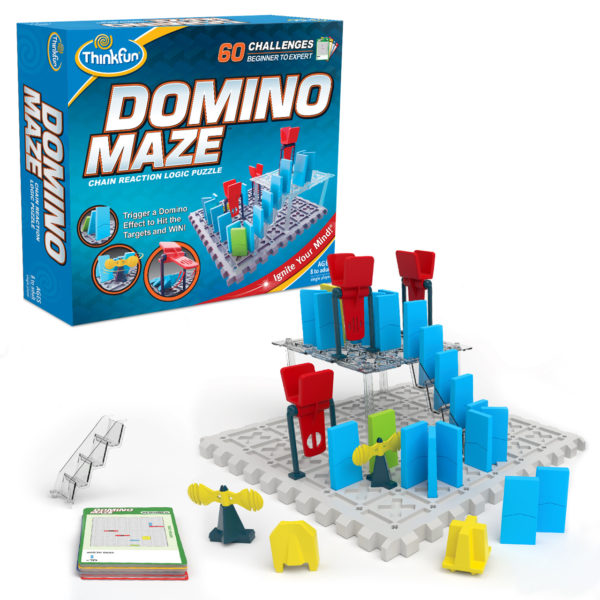
«Domino Maze», a puzzle game by Wei-Hwa Huang. Picture from Thinkfun official site.
Thank you for your time, Mr. Huang. Good luck with your future endeavors. We’re looking forward to your next game.
Pictures are taken from open sources.

